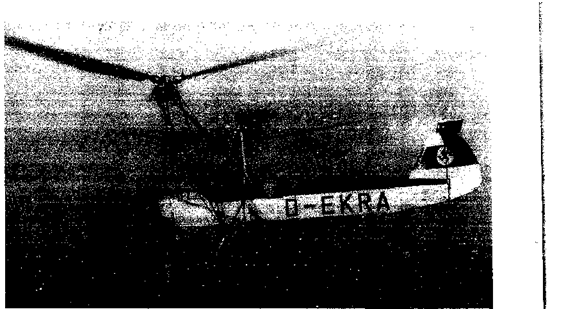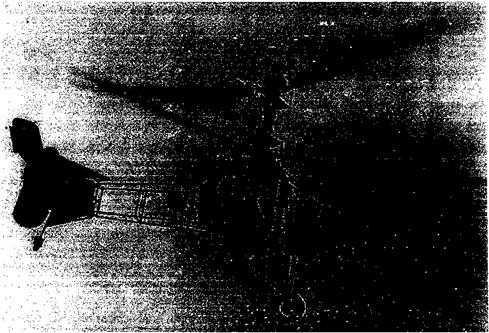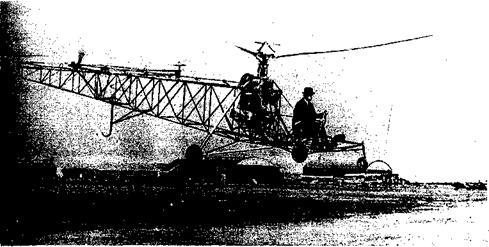The First Successes
During the period 1930-1936, the famous French aviation pioneers Louis Breguet and Rene Dorand made notable advances in helicopter development. Figure 1.22 shows their machine of 1935, which was relatively large with coaxial rotors. Boulet (1984) and Kretz (1987) give an excellent account of the work. Each rotor had two tapered blades that were mounted with flap and lag hinges and were controlled in cyclic pitch using a swashplate design. Yaw control was achieved by differential torque on one rotor with respect to the other. Horizontal and vertical tails were used for increased stability. For its time, the aircraft held several flight records, including a duration of 62 minutes and distance flown (27 mi, 44 km). This was arguably the first successful helicopter because, not only did it demonstrate a remarkable new level of performance, but it had a good level of flight safety in that it could autorotate to the ground – see page 6. Clearly, all aircraft must possess safe flight characteristics after a loss of power. While a fixed-wing aircraft can glide, the helicopter can take advantage of autorotation with the rotor unpowered as a means of maintaining rotor rpm, lift, and control in the event of engine failure. In this mode, the helicopter behaves very much like an autogiro so that the relative wind comes upward through the rotor disk. The pilot, in effect, gives up altitude (potential energy) at a controlled rate for kinetic energy to drive the rotor and, with skill, can autorotate the aircraft safely onto the ground.[9] However, with the higher disk loadings found on helicopters compared to autogiros, to get the rotor to autorotate the helicopter must descend at a relatively high rate. While autorotations were
|
Figure 1.22 The technically successful Breguet-Dorand coaxial helicopter, circa 1936. (Courtesy NASM, Smithsonian Institution, SI Neg. No. A-42078-C.) |
attempted with the Breguet-Dorand machine, some moderately successful, the aircraft crashed, and further work stopped prior to the outbreak of WW2.
Henrich Focke of the Focke Wulf Company began his work on rotating-wing aircraft as early as 1923. He acquired a license to build Cierva’s autogiros and successfully manufactured the C-19 and the C-30 models. From the experience he gained and after many wind tunnel tests, Focke began developing the Fw 61 helicopter as a private venture in 1934. Focke was later to state in a RAeS lecture [see Focke (1965)] that “I was brought to the task of making the first practical helicopter because Cierva did not do it himself.” In 1937, Henrich Focke finally built and demonstrated a successful side-by-side, two-rotor machine, called the Fw 61. The details of the machine are described by Focke (1938, 1947, 1965), Boulet (1984), and Coates (2002). Figure 1.23 shows that the rotors were mounted on outriggers and were inclined slightly inward to provide lateral stability. The blades were tapered in planform and were attached to the rotor hub by both flapping and lagging hinges. Longitudinal control was achieved by tilting the rotors forward and aft by means of a swashplate mechanism, whereas yaw control was gained by tilting the rotors differentially. The rotors had no variable collective pitch, instead using a slow and clumsy system of changing rotor speed to change the rotor thrust. A vertical rudder and horizontal tail provided additional directional stability.
Focke’s Fw 61 machine is significant in that besides demonstrating fully controlled flight, it was the first helicopter to repeatedly demonstrate successful autorotations to the ground. Provision was made in the design for a fixed low collective pitch setting to keep the rotor from stalling during the descent. It also set records at the time for duration, climb to altitude (11,427 ft, 3,427 m), forward speed (76 mph, 122 km/h), and distance flown in a straight line (143 miles, 230 km). The machine gained considerable publicity prior to the outbreak of WW2 when the famous test-pilot Hanna Reitsch flew it inside a Berlin sports
arena. While apparently portrayed as a well-mannered helicopter, Reitsch reported that it was not an easy machine to fly and it had some concerning handling defects. The Fw 61 was developed further in collaboration with Gerd Achgelis (which was known in some circles as the Fa 61) and was used as a basis to develop the Fa 266 (Fa 233E), which first flew in 1940. This was a fairly large helicopter, with two three-bladed rotors and could carry up to four crew. It went into limited production during WW2. Boulet (1984) and Coates (2002) give good accounts of the later helicopter work of Focke.
A few examples of the Fa 233 survived WW2 and were taken to Britain, France, and Russia for further evaluation. The French developed the SE 3000 from the Fa 233, which flew in 1948 but it did not go into service. Some the German machines were used as a basis to develop helicopters in Russia, a good account being given by Everett-Heath (1988). The Platt-Le Page XR-1 (see page 32), which was built in the United States after WW2 was based on the Fa 233 design. Yet, despite the apparent success of the side-by- side rotor design, it suffered from a serious lateral instability while hovering in ground effect.
With the assistance of Cierva, the Weir Company had formed an aircraft department in Scotland in 1932. The W-5 was their first true helicopter design, the W-l through W-4
![]()


batrinrr oil Кррп QiitAmmo TnirialK; tbp W_^ лі/qo о paoviqI НаоІггп іілхігрх/рг
UUTlll^ Ull UVVli UUW^Xl ) U1V Y Y «_/ YYUO U WUAim UVUlgJU) UV/VTVT vi)
various technical concerns, Weir instead capitalized on the success and apparent flight stability of the German Fw 61 and adopted the side-by-side rotor configuration with the rotors on outriggers. The resulting W-5 incorporated the engine and rotors from the W-4 autogiro and was a rather diminutive machine overall. The two rotors used two untwisted blades with full articulation using flapping and lead-lag hinges, and were given cyclic pitch capability by using a swashplate mechanism. Pitch and yaw control was obtained by tilting the rotor disks, with roll control being obtained by a differential pitch input to the rotors. There was no direct collective pitch, with rotor thrust changes being effected by changes in rotor rpm, a rather slow and unresponsive procedure that was to remain a feature of the
|
Figure 1.24 The Weir W-6 was Britain’s third helicopter and in 1939 was the first helicopter to carry a pilot and a passenger. |
later Weir-Cierva helicopter designs. The first free hovering flights of the W-5 were made in June of 1938.
The Weir W-6 retained the side-by-side rotor concept of the successful W-5, but used two, three-bladed rotors, each of 26 ft (7.93 m) in diameter. The blades were fully articulated with flapping and lead-lag hinges, with a feathering capability. As shown in Fig. 1.24, a skeletal airframe (of welded steel and light alloy tubing) formed the primary structure. Rotor control was achieved using cyclic and differential collective pitch, with the same method of changing rotor rpm used on the W-5 to effect changes in rotor thrust. The first flights of the W-6 were conducted during October of 1939 and the machine demonstrated good control and performance with speeds in forward flight of over 80 mph and rates of climb in excess of 600 ft/min (3.05 m/s) being attained. See Everett-Heath (1986) and Leishman (2002b, 2004) for further information on the Weir machines.
The imminent outbreak of WW2 ended all research and development on British rotor – craft. The Government’s effective moratorium on British rotorcraft developments in favor of the American Sikorsky designs, albeit only for a few years, was to be a serious blow to the Cierva, Weir, and Hafner companies. It was not to be until 1943, in response to the first official British government design specification for a helicopter, that British rotorcraft development was to start again. By that time, the US had accelerated into the technical lead. With the rapid advances by Igor Sikorsky in 1939 and early 1940s, engineers in the US were to shelve any further technical development of the autogiro and were to focus all new work on helicopters. Much of the future technical work on rotorcraft, both experimental and theoretical, took up where the autogiro had left off. In Britain, this saw the revival of the Cierva Company in 1944 and the development of the Cierva W-9, which was a single rotor helicopter.
During the period 1938-1943, Anton Flettner of Germany developed several helicopter designs. His FI 184 was an autogiro but like the Hafner AR. III it used cyclic pitch control, allowing the pilot to tilt the rotor. This machine was modified to a single rotor shaft driven helicopter (the FI 185), with the addition of collective pitch control and two smaller differentially thrusting propellers on outriggers for anti-torque. While the FI 185 flew, Flettner’s big success came with using a side-by-side intermeshing rotor configuration, which became known as a synchropter – see Braun (2003). This intermeshing design was first patented by Bourcart in 1903 and by Mees in 1910. In the synchropter design, the rotor shafts are close
together but arranged so that they are at a significant outward angle with the overlapping rotors turning in opposite directions [see Fig. 1.3(e)]. A gearing system ensured the exact phasing of the rotors. In 1939, Flettner’s FI 265 synchropter was the first helicopter to demonstrate transition into autorotation and then back again into powered flight. Flettner built several other machines, including the FI 282 Hummingbird. The FI 282 was probably one of the first helicopters to be produced in quantity and saw some limited use (but no operational service) during WW2 – see Coates (2002). In the United States, the Kellett Aircraft Company (which also built autogiros as a licensee to Pitcairn) also developed a synchropter configuration and built the XR-8 in 1944 using three-bladed intermeshing rotors. The aircraft flew successfully, but it never went into production. The synchropter concept was also adopted by Charles Kaman, but this time the Kaman Aircraft Corp. was to put the type into quantity production for the US military.
In the early 1940s Friedrich von Doblhoff of Germany began investigating the application of the tip-jet principle to a helicopter and by 1942 had built the first helicopter to take off using tip jets. A conventional piston engine drove a compressor, and the compressed air was mixed with fuel before passing through hollow rotor blades to combustion chambers situated at the blade tips. Because of their high specific fuel consumption, tip jets can be used economically only for takeoff, hovering and landing. For forward flight, the tip jets were shut off and the rotor operated in autorotation like an autogiro. After WW2, von Doblhoff was involved in the development of the McDonnell XV-1 compound helicopter – see Section 12.17.
The Americans too were working on helicopter designs. As described earlier, Igor Sikorsky had experimented in Czarist Russia with primitive vertical lift aircraft as early as 1907 – see Sikorsky (1938) and Finne (1987). After Sikorsky had emigrated to the United States, he went on to design and build flying boats. A 1935 Sikorsky patent (No. 1,994,488) shows a relatively modem-looking single rotor/tail rotor helicopter design with flapping hinges and a form of cyclic pitch control. Although Sikorsky encountered many technical challenges, he tackled them systematically and carefully. To some the machine was known as “Igor’s folly,” an unjustified designation by those who did not believe in the future of rotating-wing aircraft, but it also reflected the relative mechanical complexity and difficult flying characteristics of the early helicopter prototypes. Sikorsky’s first helicopter, the VS – 300, was flying in free, untethered flight by May 1940. A good summary of the technical design is given by Sikorsky (1941, 1942,1943).
Sikorsky’s first machine (Fig. 1.25) had one main rotor and three auxiliary tail rotors, with longitudinal and lateral control being obtained by means of pitch variations on the two vertically thrusting horizontal tail rotors. The machine could hover, fly sidewards and backwards, yet it could not fly forward very well, exhibiting a sudden nose-up pitching characteristic at a low forward airspeeds. This was because of the downwash of the main rotor wake, which as airspeed built, blew back onto the two vertically thrusting tail rotors and destroyed their lift. The main lifting rotor of the VS-300 was used in the later VS-300A, but now only the vertical (sideward thrusting) tail rotor was retained out of the original three auxiliary rotors. In this configuration, longitudinal and lateral control was achieved by tilting the main rotor by means of cyclic pitch inputs; the single tail rotor was used for anti-torque and directional (yaw) control purposes. This configuration was to become the standard for most later helicopters.
In June of 1941, the Platt-LePage XR-1 helicopter was to make its first free flights. Developed by two American engineers, W. Laurence LePage and Havilland H. Platt, the XR-1 was funded by a government contract under the Dorsey-Logan Act (see page 713). W. Laurence LePage had previously worked the Pitcairn and Kellett companies. The XR-1 followed the lead of the Focke Fw 61 by using a side-by-side rotor configuration. The
|
Figure 1.25 Sikorsky’s VS-300 helicopter flew in 1940 and pioneered the single rotor configuration, but it followed several European helicopter designs. (Photo courtesy of Sikorsky Aircraft.) |
XR-1 was found to be difficult to fly, with high vibrations and control problems. Several years of development followed, although its capabilities were soon eclipsed by the Sikorsky machines and the XR-1 was never to go into production. After WWII, McDonnell continued to develop the side-by-side rotor concept under contract to the US Navy. The McDonnell XHJD-1 Whirlaway was a similar but larger and heavier helicopter than the XR-1, using a separate engine to drive each rotor. Like the XR-1, the XHJD-1 was to suffer from a host of technical problems and McDonnell quickly fell behind the Sikorsky and Piasecki Companies in helicopter development. While the side-by-side rotor configuration proved to be a bad design choice for helicopters, it is perhaps significant to note that the configuration was later adopted for use in tilt-rotors – see Section 1.13.
















